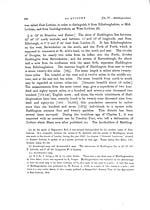Volume 3
(410) Page 397
Download files
Individual page:
Thumbnail gallery: Grid view | List view

397 Halden, the son of Eadulf (e). It is apparent, then, that some such person gave his name to the town, ton, or tun, though he cannot now be personally introduced to the more curious reader (f). Haddington does not much appear on the face of the national annals during the middle ages. Yet we have seen that it had acquired the privileges and pre-eminence of a burgh as early as the reign of David I. Thus much, then, with regard to the shire-town and its name. The area of this county seems to have been called Bernicia, from the abdication of the Romans till the epoch of 1020, when the whole district was ceded by the Northumbrian earl to the Scottish king (g). From the epoch of 1020, the ample country lying along the sea, and the Forth, from the Tweed to the Avon, was denominated by the Saxon settlers, from their native lan- guage, Lothian, with an allusion to its peculiar jurisdiction on a litigious frontier. Lothian was still known as a country, distinct from Scotland, during the reign of David I. (A). During the reign of his grandson, William the Lion, the Lammermuir range became the southern boundary of Lothian (i). Soon after, both in popular tradition, and in public proceedings, the area of this shire (e) Dal. Col., p. 340. We may see in Speed's map of Northumberland 1610, a place named Haden-bridge. There are Haden-ham in Cambridgeshire, Haddon-hall in Derby, Haddon in Hunting- don, and Haddon in Northampton. See the villare of Adams. Adington, which often appears in the topography of North and South-Britain, is the same in substance with the Saxon aspirate (H) prefixed ; and there is a place named Hadington in Lincolnshire, as we know from the Inquisitio Post Mortem, 305. (f) The writer of the prefatory introduction to the account of Lothian in Blaeu's Atlas Scoti�, 1G62, supposes the name of this shire-town to be Hadtyn-tourn, as it is situated upon the river Tyne; yet this form of the word is assumption against the charters of the 12th century, and is moreover inconsistent with the analogy of the thing. (g) See Smith's Bede : " Berniciorum a mari Scotico terminata est." Ib., App. ii., and the map annexed to it. Such then was the Bernicia of Bede. (h) Caledonia, i., 258-9). Even before the demise of David I. Cockburnspath, which is situated in the north-west, corner of Berwickshire, appears to have been deemed a boundary. David I., when he founded Holyroodhouse, granted to its monks the tenth of all the marine animals which might be thrown ashore " ab Avon usque ad Colbrandspath," with the tenth of his pleas and other dues within the same limits. These grants were confirmed by David II.. referring to the same limits. Roberts. Index, 90. (i) There is a charter of Rolland, the son of Uchtred, who became constable of Scotland in 1196, granting some land in Upper Lauderdale to Alan de St. Clair, which William de Morville had given him, and settling its limits " de capite langild [the rivulet] usque ad divisas de Luodonia versus Lamberlauwe," [Lammer-law]. Diplom. Scoti�, pl. Ixxxi. From the age of David I. to the reign of David II., the extent of Lothian seems to have been from the Avon to Cockburnspath.
Set display mode to:
![]() Universal Viewer |
Universal Viewer | ![]() Mirador |
Large image | Transcription
Mirador |
Large image | Transcription
Images and transcriptions on this page, including medium image downloads, may be used under the Creative Commons Attribution 4.0 International Licence unless otherwise stated. ![]()
| Caledonia, or, An account, historical and topographic of North Britain from the most ancient to the present times > Volume 3 > (410) Page 397 |
|---|
| Permanent URL | https://digital.nls.uk/74528894 |
|---|---|
| Description | Vol. III. |
|---|---|
| Attribution and copyright: |
|

